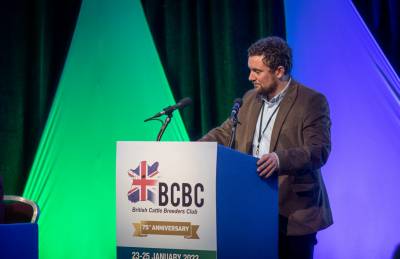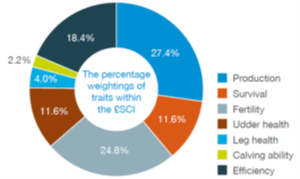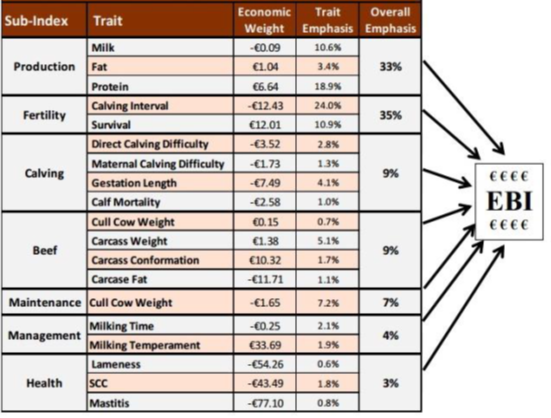
Background
My family and I farm just under 150 acres in Holywell, Flintshire where we milk over 100 spring calving herd of Black and White cows along with 80 followers. We aim to calve as many within 9 weeks from the 1st of March to the beginning of May, with empty cows culled or carried over and sold as fresh calvers in Mold market during the late summer months. In the past we have operated an all year round and autumn calving system based on grazing, but since 2008 we have operated a spring calving system and now supply Arla on a manufacturing contract. I have been interested in our herds genetics since we registered our first pedigree cow back in 1983 and have milk recorded for over 35 years allowing us to look back on nearly ten generations worth of information. Holstein blood has played a large part in our herd for many years and myself and my father still look for balanced cows with width throughout, correct mammary systems and excellent locomotion. During the transition over to a grass and block calving system we soon found out that the mainly North American origin Holstein breed in the herd lacked in terms of fertility, milk solids and condition score. Therefore, we introduced Black and White genetics from New Zealand along with some Irish and Dutch Holstein Friesian. These matings resulted in a much more suitable cow for the system. This was then followed by the dawn of the Genomic era which widened the choice of Black and White bulls even further. Despite this, there is still a huge variation in the herd from the high yielding Holstein type to the smaller NZ Kiwi cross.
In the UK the main Index to help farmers select and breed for profitable cows is the £PLI (Profitable lifetime Index) which for years was the only Index available to rank bulls and cows on regardless of the system you operated. In 2014 AHDB Dairy launched the £SCI (Spring Calving Index) and in Summer 2018 launched the £ACI (Autumn Calving Index). All three systems are to complement AHDB’s optimal dairy systems strategy. Currently we use three Indexes to help choose bulls and select cows for matings - The £PLI, £SCI and $BW (Breeding Worth - New Zealand dollar).

Chart 1. Emphasis on different traits within the Spring Calving Index (£SCI)
History and make-up of the EBI
The EBI was introduced in 2001 to replace the RBI (Relative Breeding Index) which was primarily made up of production traits including Kg Milk yield which led to many foreign sires populating the top ranks of each proof run with their converted data and not based under actual Irish environmental conditions. With the formation of the EBI, a greater emphasis was placed on other economic traits of importance such as fertility and milk solids, especially protein. Other notable aspects of the EBI are the inclusion of beef characteristics which has helped increase cull cow values and allowed the beef cross industry to benefit without compromising the total amount of KgMS produced. Table 1 below shows relative emphasis of different traits of the EBI.

Table 1. Relative emphasis of the main sub-index traits on the overall EBI
Each €1 gain in a Herds average EBI is worth €1.96 per cow per lactation in terms of net profit. For a 100 cow herd with a €150 EBI over a same sized herd with a €50 EBI average, this would be equivalent to an additional €19,600 profit.
Study tour to Ireland
In October 2018 I travelled to Ireland and embarked on a 4 day tour of Irish dairy herds. The reason I wanted to visit Ireland was not only to see the type of Black and White cow the Economic Breeding Index (EBI) was producing but also how the industry fed data into the genomic and daughter proving system along with any research carried out to underpin the Index. Ireland has very similar conditions to Wales in terms of topography and climate with an ability to grow grass with a strong emphasis on processing for cheese and other products. Eighty five percent of Irish dairy herds operate on a block calving grass based system therefore the main focus has been on breeding a suitable cow for that particular system. Many of the available bulls for grazing in the UK studs are also Irish bred.
Key findings of the tour were:
- Close links between all industry partners - less friction than UK (or so it seems)
- Genetic indexes backed up with focused research at Teagasc
- An index not dictated by big AI companies and topped by foreign bulls with converted proofs
- One system approach as an industry
- EBI held well post quota abolition
- Cull and beef cross calves an important aspect of EBI make up
- Focus always on efficient grass utilisation
- High EBI cows are moderate sized, get in calf easily and have high milk solids
- Possible to breed Black and White cows with Jersey like solids and crossbred like fertility
- Through widespread Genotyping of bull calves, ICBF improving all herds not just EBI focused herds as High EBI sweeper bulls and cheap elite young bulls used almost unknowingly by the more commercially minded farmers
- Lifestyle important to all farmers and that the cow should work for them, not the other way round
Next steps
The exchange opened my eyes and further reinforced what I suspected we needed to improve on not only on the type of cow but also on how we manage her and the herd as a whole.
- Tighten the calving block and front load B&W sires - One of the first things that needs to happen is to stop any cows calving to Black and White bulls after the nine weeks - too many females are kept as replacement from these later calving cows furthering their legacy of compromised fertility. Culling of these cows should be considered either as barren cows or sold as fresh calvers during May and June. Not only will this improve the management of fresh and early lactation cows it will also ensure lower fertility is not inherited into the herd.
- Choose one Index to select bulls - or ensure Indexes are converted as accurately as possible to the index of choice. Use Clarifide genomic interpretation tool to develop a ‘Moor Farm Spring Calving Index’.
- Use selection tools to rank females in the herd - i.e Calving Interval, Total KgMS/Cow, KgMS/KgLW and KgMS/Day. This should replace yardsticks for selection such as Milk Kgs, Classification scores and on who the dam and grand-dam was.
- Identify an elite group of genomically tested heifer calves - from cows with good fertility records and milk solids and track progress against other groups of animals.
- Incorporate flat rate feeding in the parlour - the current feeding regime of concentrate leads to variability in intakes and on a dry year like this year, lighter and younger animals have not had their full allocation of dry matter leading to some issues with lower BCS than normal. New parlour feeders to be considered.
Conclusion
The Exchange started off as being an opportunity to look at what sort of cows the EBI was responsible for breeding, however I quickly realised the EBI was a result of much wider Industry integration that was also partly driven by government department policies. The work of Teagasc is also important in facilitating effective research and focused KT, this none more evident than in the quick and effective response by the exchange farms Teagasc advisors in my assistance for which I am very grateful. All farmers along with the institutions that I visited were very open about their farming business and were more than happy to engage in frank and open discussions which is as refreshing to see as it is informative. Without this openness the exchange outcomes wouldn’t have been achieved. Again, this lateral industry co-operation has also been key to the success of the EBI.
It is also very apparent that individual breed societies, the showing circuit and AI companies have much less sway in Ireland compared to the UK, allowing breed development to be focused on feed efficiencies, animal health whilst also being linked to overall farm profit.
Lastly, on the high EBI cow herself, she is a no fuss, 550kg moderately sized functional Black & White animal capable of achieving 5000 - 8000kg+ on mainly grass and limited concentrate whilst easily achieving 9% solids. She displays strong early heats and gets back in calf quickly with only one service after transitioning seamlessly from the dry period to early lactation where she holds condition during the often interchangeable weather at turnout. She’s a cow you can see over, but not under her with a wide muzzle and deep capacious body which allows for high grass dry matter intakes which leads to efficient conversion of grass to milk. At the same time large volumes of milk is being held hygienically in a functional well attached udder where she goes on to milk out quickly before moving easily and freely back to the grazing paddock. Using her slightly sickled leg set with plenty of flex in the pastern and good depth of heel for excellent locomotion to ensure a lameness free lactation regardless of walking surface. And when she finally does reach the end of her time on the farm, often approaching her tenth lactation, she is still fit and well fleshed enough to further increase profits for her owner’s farm.
Acknowledgments
George Ramsbottom – Teagasc, Farming Connect Management Exchange Team & all host Farms and ICBF.
View Rhys Davies full Farming Connect Management Exchange report at rhys_davies_report_management_exchange_-_impact_of_ebi_v2_0.pdf (gov.wales)
Photography Credit @Jenny Wood Photography